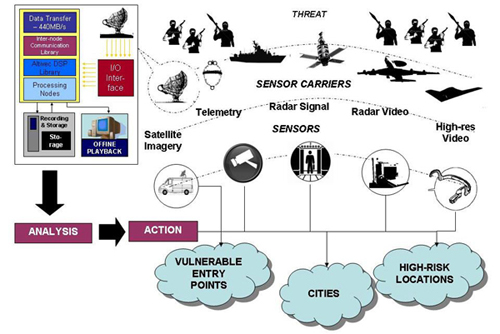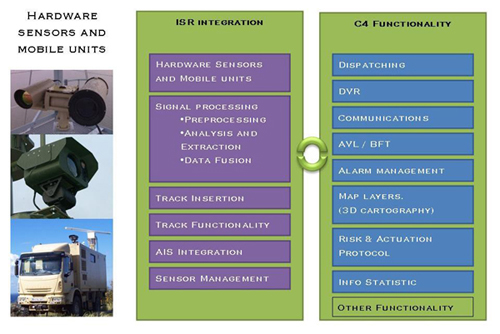Introduction
C4ISR stands for Command, Control, Communications, Computing, and Intelligence, Security, Reconnaissance, and was formulated by the US Department of Defense (DoD) in response to the need to evolve a mechanism for integrating and acting on combat information coming from various sources and geographies and media.A C4ISR System can be thought of as a framework for organizing multi-media information emanating from a situation (typically a crisis), in a manner that enables non-local users to analyse such information (from multiple sources); act on that information or advise local players on actions to be taken; receive feedback from local players on actions taken; based on which a follow-up set of actions or advice can be initiated, towards the objective of resolving the situation to the advantage of the users.
C4ISR and Homeland Security
C4ISR has been adapted, from its military origins, for Homeland Security given the similarity in the situations faced by a city reeling from a terrorist strike or a major conflagration, and an army battalion in hostile action.C4ISR can form the basis of Homeland Security solutions for border surveillance, critical infrastructure protection, emergency response, and force tracking. This is how such a solution would look:
| Communications | Ability to integrate various communications protocols: GSM, VHF/UHF/HF, Tetra, PSTN, etc. |
| Computing | Applications such as Cartography, Databases, Simulation, Analytics; and functionality such as interoperability of systems, handling multi-media content |
| Command | Tools for Data Mining, DSS |
| Control | Real-time transmission and receipt of all information, under any circumstance, using protocols |
| Intelligence | Humint, Sigint |
| Surveillance | Sensors |
| Reconnaissance | Sensors, Sensor carriers |
Given below is a standard border surveillance solution, deployed by users; with sensors, sensor carriers, communications framework, databases, and analytics:

A C4ISR approach to the above architecture will map user objectives to the C4ISR functionality:

Desiderata for a C4ISR implementation:
Choosing a Homeland Security solution – border surveillance, critical infrastructure protection, emergency response, or force tracking – based on a C4ISR framework should be a decision taken on the basis of support for the following functionality:
Interoperability:
By interacting with legacy systems of involved agencies and with deployed mobile units as well, it is possible to develop a higher resolution picture of a crisis situation. For this purpose, a data model such as the standard JC3IEDM should be used, and web services should be XML-based.
Sharing Mechanism:
Sensor data should be managed by Publication/Subscription mechanisms: the operator subscribes to the information or services offered by the solution, which incorporates a middleware layer in charge of searching for the information and publishing it to subscribers. This allows information to be received and consolidated in a database in real time.
Openness:
Sensor-independence allows the solution to integrate new sensors (based on new technologies) at a future point in time. Cartographic independence allows the solution to support a variety of map formats.
Architecture:
A decentralized and Services-Oriented-Architecture (SOA) allows the system to be managed from any fixed or mobile network device, providing an added robustness, in the event of failures or crisis situations.
Low-bandwidth protocol:
Data synchronization mechanisms used should allow information to be shared in real time, at rates as low as < 10 kbps, for the solution to function effectively in crisis situations.
Conclusion
C4ISR is no longer just a military term and restricted to military usage. Given the nature and intensity of threats faced by a government within its borders, it is imperative that administrators adopt a C4ISR approach to their implementations of homeland security solutions. Mistral offers the Amper C4ISRnemesis product line for Homeland Security needs in India. The product line consists of the following solutions:




